Tuesday, May 7, 2024
News and Views from the Global South
Climate Change Justice
Climate Crisis in Mountains: Borderless Struggle for Frontline Communities

Climate change-induced flooding has devastated the lives of people living on the Indian and Nepalese sides of the Hindu Kush Himalaya. Although the floods have destroyed their lives and livelihoods, as this cross-border collaboration narrates, neither community has received any substantial compensation.
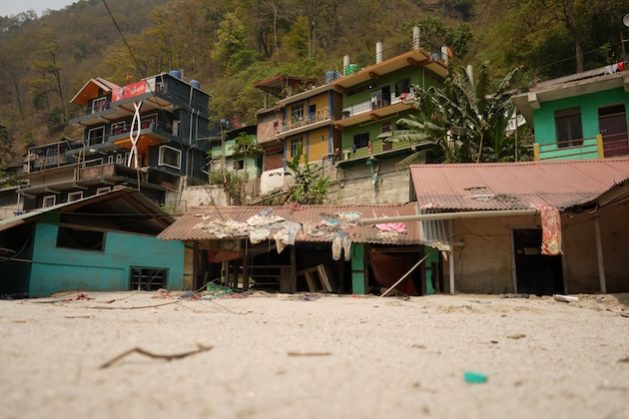
Damage to property from sand and silt deposited after the flood near Teesta Bazar in West Bengal. Residents in this region have not received any meaningful compensation for their losses. Credit: Ashutosh Kumar/IPS
- For the last three years, Sambhunath Guragain has been waking up every morning to a view he doesn’t want to see: discarded agricultural land where he and his family used to grow food, including rice, but the flood in 2021 changed everything.
“We don’t have any crops now, but we are farmers,” Guragain said in November 2021, while looking towards a quietly flowing Melamchi river. This was six months after the massive flash flood in Helambu-Melamchi in Sindhupalchowk district in Nepal. After three years, the situation hasn’t changed.
“It’s the same; nothing has changed. We are farmers, but we have to buy everything,” Guragain, who lives in Jyamire, a village in Helambu Rural Municipality 2, said. “And the river is flowing in parts of our farmland, while other parts are covered with sand, stones, and debris.”
In neighboring village Halde, Pashang Sherpa is still unable to recover his farmland that was swept away by a massive flash flood. “Destruction is still raw; there are damaged houses, and our land turned into a river and riverbank.”
In June 2021, the Helambu-Melamchi flood claimed lives and caused socio-economic destruction. Local people like Sherpa and Guragain, who were on the frontlines, are still dealing with the consequences.
In the same Himalayan region (Hindu Kush Himalaya-HKH), but on the other side of the border, communities in Sikkim, India, are dealing with almost similar situations.
For over six months now, Goma Sundas from Teesta Bazar has been residing in a relief camp situated on the banks of the River Teesta in the Kalimpong district of West Bengal.
“It’s been half a year since I witnessed the heartbreaking sight of my home being swallowed by the Teesta River,” she recalls. Early on October 4, 2023, heavy rainfall caused the South Lhonak lake in Sikkim to overflow, triggering a glacial lake outburst flood that surged towards the Teesta III Dam at Chungthang. As the flood breached the dam’s banks, it collapsed within minutes, causing havoc downstream.
Further along the river, the floodwaters wreaked havoc on the power station and bridge of the 510 MW Teesta V. Fueled by water from the reservoir, it cascaded down the hillsides, causing landslides and carrying a chaotic mix of water, mud, and debris.
Moving at incredible speed, it reached Singtam valley settlements in just 1 hour and 40 minutes, Kirney near Melli, West Bengal, in 36 minutes, and Teesta Bazar in 30 minutes, sweeping away everything in its path—people, homes, bridges, animals, vehicles, and machinery. Severe damage to lives, property, and infrastructure was reported in four districts of Sikkim and downstream areas of northern Bengal in India.
“I always dreamed of having my own home because I grew up in a rented one. It took half my life to build it. But in just a few seconds, the river swept it away,” shares 34-year-old Sundas, wiping away tears. Her house, once near a playground, is now submerged along with the playground itself. Sundas is now homeless and without a job. She used to run a small eatery. Over 200 houses in Teesta Bazar were damaged or washed away in the flood.
Sundas and nine other families now reside in a relief camp, seeking shelter after losing everything. Roshni Khatun, also in the camp, explains they’ve received donations for basics from NGOs and local authorities. Khatun’s family, like Sundas’, lost their home in the 2023 Teesta flood.
The government provided Rs. 75,000 (USD 900) in compensation to flood-affected families. Sundas mentions that the local government promised land for new homes, but six months later, they’re still waiting for it.
According to the scientific report, the cause of the Melamchi Flood was a mix of a small glacier lake burst and unusually heavy rainfall in the high mountains, indicating that climate change-induced extreme weather events are the reasons behind the pain that farmers are going through. In a time of changing climates and increasing vulnerability to disasters, mountain communities are dealing with post-disaster consequences while having little or no support from stakeholders and waiting for another possible disaster without any preparedness.
“We haven’t received any support to recover our agricultural land or find another piece of land to grow food,” Guragain explained, expressing his suffering. “We farmers are the ones who lost livelihoods and are ignored by the government from local to federal levels.”
Farmers Are Suffering and Neglected in Nepal
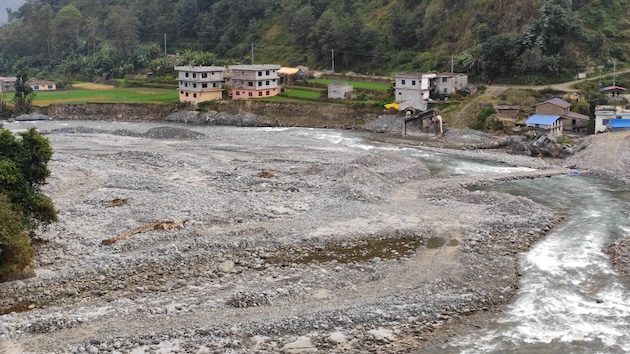
Almost three years after the floods, locals living in Melamchi-Helambu in Nepal are still struggling. Credit: Tanka Dhakal/IPS
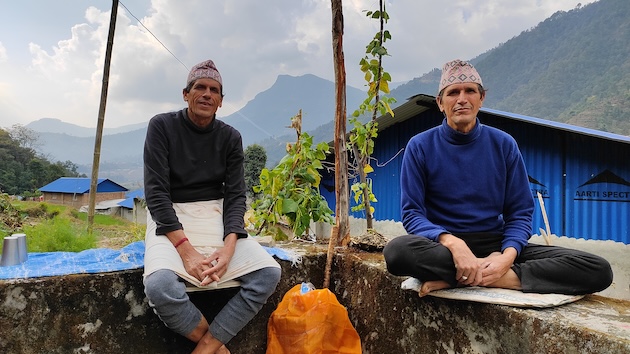
Sambhunath Guragain (right) and his family lost their agricultural land and it’s been three years since they have been able to grow any crops. Credit: Tanka Dhakal/IPS
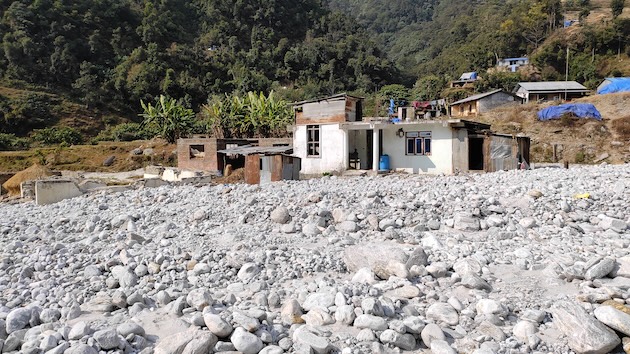
The Melamchi-Helambu flood impacted houses and fields which is affecting livelihoods. Credit: Tanka Dhakal/IPS
Even though the livelihoods of people living on the frontlines, like in Helambu-Melamchi, where the impact of climate change-induced extreme events is already evident, largely depends on agricultural activities, farmers and the impact on agriculture aren’t supported by stakeholders.
“We feel like nobody cares about us; we grow food-not only for ourselves but for everyone,” Dawa Sherpa (Pasang Sherpa’s wife) shares her bitter experience. “We are suffering and being neglected by the government. Nobody asks how we are surviving and what it feels like to be in a situation where we are not able to grow food.”
The local government confirmed that it has not taken any action to support farmers who lost agricultural land in the flood. According to the Information Officer at the Helambu Rural Municipality, there has been no effort yet specifically targeting farmers.
“We have only collected data, and it is true that we don’t have a support program dedicated to farmers because we lack resources,” Information Officer Top Bahadur Baruwal said. “The impact is evident; farmers are unable to find a way to return to farming, and we are not in a position to offer support in any way.”
The flood swept away at least 2200 Ropani (276 Acres) of agricultural land in Helambu and about 100 Acres in Melamchi Municipality.
“Farmers are in a painful situation,” Baruwal agreed, acknowledging the need to focus on farmers, but at the same time, he admitted: “We don’t have the resources to support them.”
Last year, they attempted to remove debris from the fields and constructed a stone wall to divert the river flow, but the August flood swept that away.
According to a recently published assessment report, the economic loss per household from the flood in Helambu and Melamchi amounted to USD 52,113, which includes agricultural losses as well.
The Locally led assessment of loss and damage finance in Nepal: A case of the Melamchi flood 2021 report reads, “On average, each household received only about USD 380, with some receiving as little as USD 76 while others received as much as USD 3,800 for reconstruction.”
Immediately after the flood, the government and aid agencies provided some monetary and food relief to the community, but soon after, they were forgotten.
“That flood ‘killed farmers.’ We are now farmers in name only,” Guragain said as he looked at the river flowing through his agricultural land. “The local government provided a small amount to rebuild houses, but nothing to help us find our livelihood, our agriculture.”
In Sikkim, Housing Is Where Locals Are Struggling
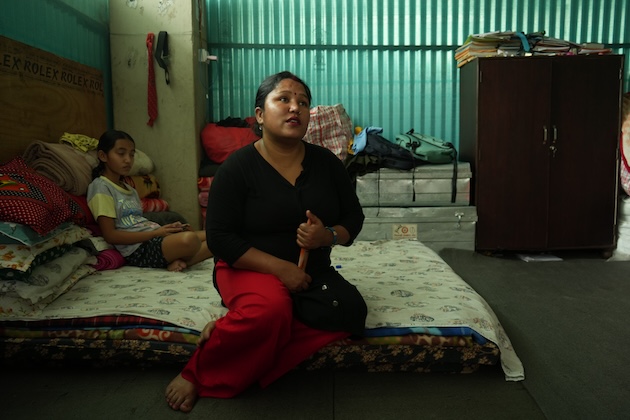
Goma Sundas, who lost her house, now lives in temporary housing in a relief camp in Teesta Bazar while waiting for support to build a house. Credit: Ashutosh Kumar/IPS
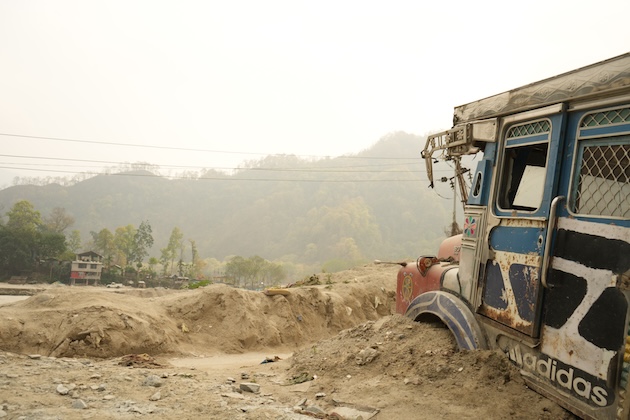
A damaged truck sits on top of a silt deposit in Rangpo, Sikkim. Credit: Ashutosh Kumar/IPS
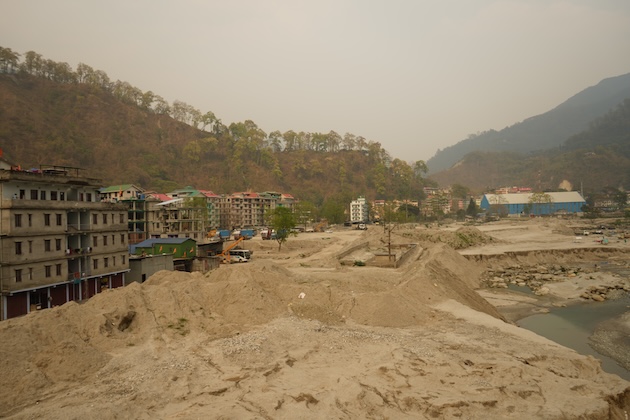
Sand and silt deposits are still present after the 2023 floods in Rangpo, Sikkim. Credit: Ashutosh Kumar/IPS
After almost three years of the massive flood, locals in Helambu and Melamchi are still building houses with nominal support from the government. However, in north Bengal and Sikkim in India, which also experienced a massive flood in 2023, affected families are still living in temporary or community buildings.
In Sikkim, flood victims who lost or had their houses damaged received nearly twice as much compensation compared to what Bengal provided.
“My family got 130 thousand rupees (USD1558) as compensation from the Sikkim government after my house got damaged in the flood,” says Ved Sharma, who lives in the Industrial Belt (IBM) area of Rangpo.
Rangpo is a town near West Bengal’s Kalimpong district. More than 150 houses in the Industrial Belt (IBM) area of Rangpo, situated along the Teesta riverbanks, were affected. Sharma mentioned that most residents whose houses were damaged or still submerged in the flood are currently living in rented homes nearby. He too has lived with his family for over six months in a two-room rented house.
The compensation is solely for Sikkim residents.
“We received nothing because we’re not from Sikkim,” stated a migrant worker from Bihar who worked as a daily wage laborer in a garage. Preferring anonymity, he disclosed, “I’ve lived in a rented house in the IBM area of Rangpo for over five years. Now, my belongings are damaged and buried in silt and sand deposited by the flood.”
Rangpo and Singtam were hit the hardest in Sikkim. Near the riverbanks, settlements are still buried under sand and silt. Even after six months, many houses and shops remain partially submerged under feet of sand. Since we don’t know how many people lived here, we still don’t know exactly how many have been forced to leave.
Changing Climate and Borderless Pain
Nepal and India share the same mountain range, the Himalayas, which separate the plains of the Indian subcontinent from the Tibetan Plateau. This region boasts the highest mountains in the world, including the world’s tallest mountain, Mt. Everest. Scientists are warning of intense and worsening impacts of rising temperatures in the region and calling for action.
A recent report on the impact of climate change in the mountains of the Hindu Kush Himalayan (HKH) region–which is a combination of the Hindu Kush and Himalayan Mountain systems–published by the International Centre for Integrated Mountain Development (ICIMOD), warned that the changes to the glaciers, snow, and permafrost driven by global warming are unprecedented and largely irreversible.
The report finds that glaciers in the HKH could lose up to 80 percent of their current volume by the end of the century on current emissions trajectories and calls for urgent action.
Research suggests that the flood in 2021 in Helambu-Melamchi, which damaged nearly completed major drinking water projects and affected communities, was climate change-induced.
This was seen in the recent Sikkim glacial outburst. Warmer temperatures make glaciers melt more, which makes these lakes bigger and less stable, and the communities downstream are more at risk.
Though local experts claim that GLOF in Sikkim may have been an ecological event, the ensuing disaster and destruction were undoubtedly worsened by the cascade dams along the Teesta’s course and unplanned housing on the river banks.
Despite numerous warnings, people and administration in Sikkim and Bengal failed to anticipate the looming Sikkim glacial lake outburst flood.
Over the past two decades, government agencies and research studies have repeatedly highlighted the potential for glacial lake outburst floods (GLOFs) in Sikkim, posing significant threats to life and property.
A study conducted by the National Remote Sensing Centre and the Indian Space Research Organisation in 2012–2013 examined the formation of a moraine-dammed glacial lake at the snout of the South Lhonak glacier and the associated risks.
Ritwick Dutta, the lawyer representing the Affected Citizens of Teesta (ACT) in their litigation against NHPC (National Hydroelectric Power Corporation), an Indian hydroelectric power generation company, emphasized the urgency of not constructing the Chumthang Dam Teesta-III hydroelectric project before the National Environment Appellate Authority.
Dutta highlighted the imminent dangers posed by climate change and glacial lake floods. He remarked, “Despite our efforts, the authority dismissed our case, dismissing most of our concerns as fear mongering. However, within just 15 years, reality spoke for itself when the Chumthang Dam became the first hydropower project to be entirely demolished by a GLOF.”
The 1,200-megawatt hydropower project was constructed in 2008. It was built at a staggering cost of Rs 25,000 crore.
The plight of locals in climate change-vulnerable places is growing, and disasters like flash floods and their aftermath are adding another layer of suffering to the community.
Goma Sundas’s words resonate deeply.
“I couldn’t finish my education because my parents were poor. Now, with nothing and relying on charity, I feel like I’ve come full circle. I fear my daughter won’t be able to continue her education at a relief camp.”
IPS UN Bureau Report
This feature is published with the support of Open Society Foundations.

 Print
Print



